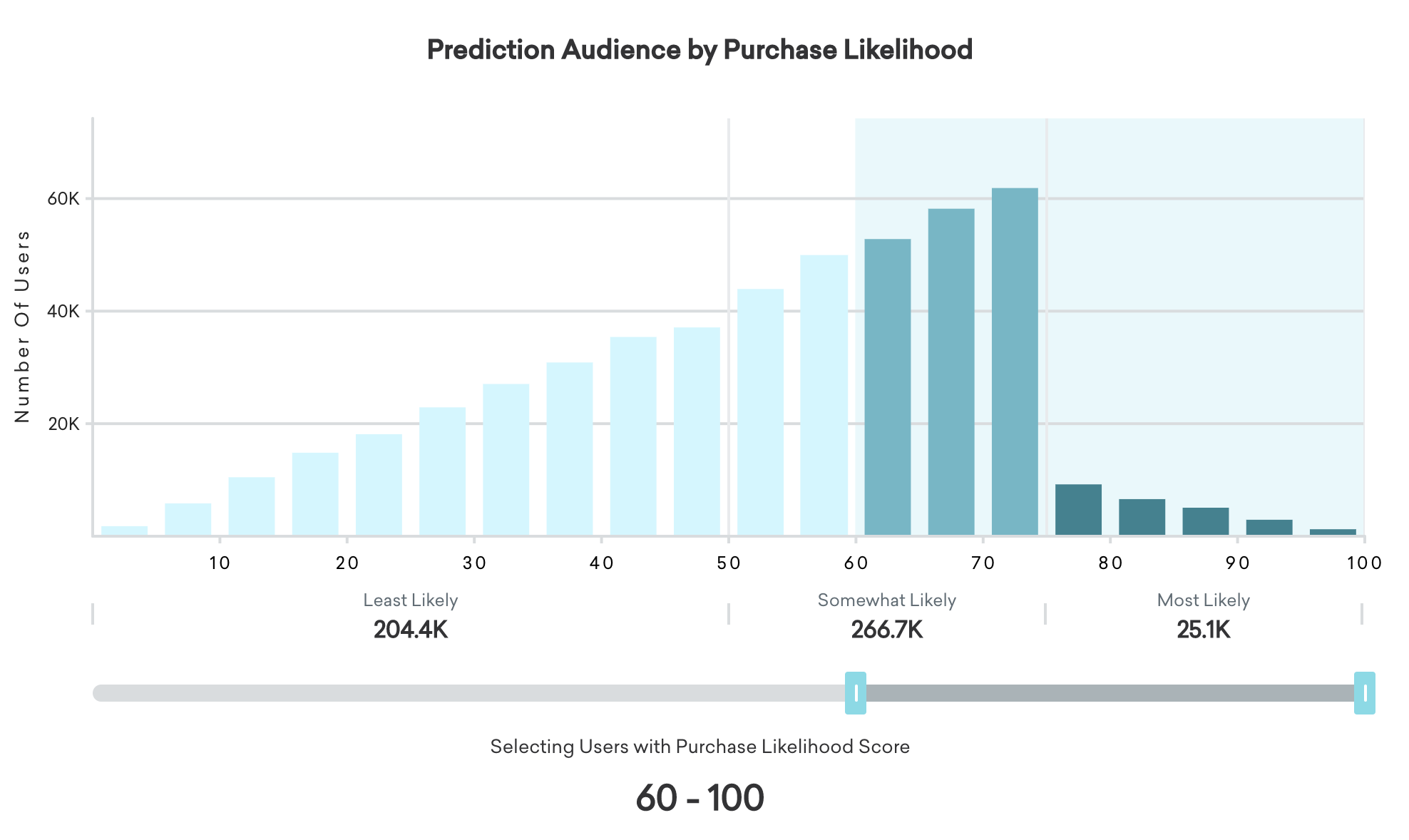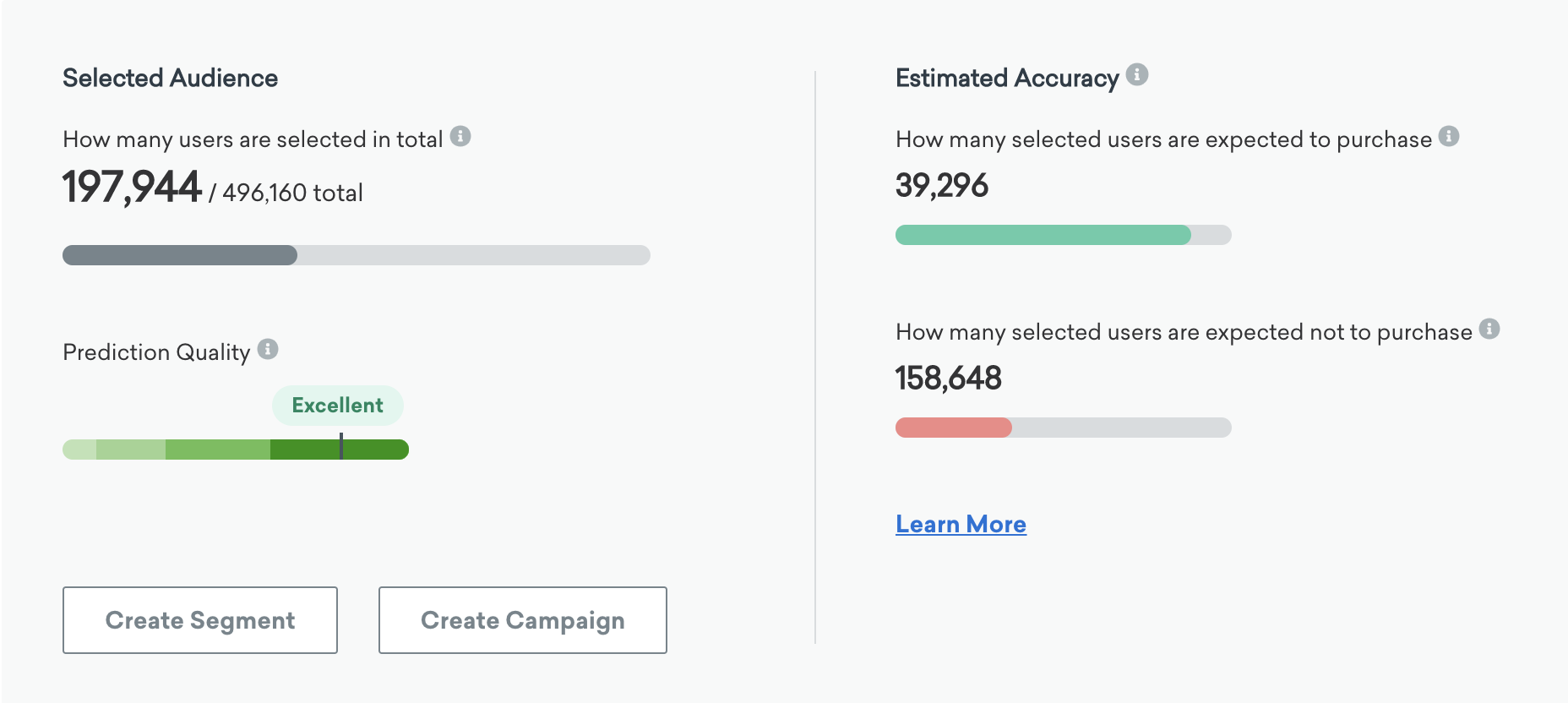Prediction analytics
After your prediction has been built and trained, you will have access to the Prediction Analytics page. This page helps you decide what users you should target based on their likelihood score or category.
As soon as the prediction is done training and this page is populated, you can start using filters in segments or campaigns to begin using the outputs of the model. If you want help deciding who to target and why, this page can help based on the historical accuracy of the model and your own business goals.
Analytics components
Likelihood score
Users in the prediction audience will be assigned a likelihood score between 0 and 100. The higher the score, the greater the likelihood of performing the event.
The following is how a user is categorized depending on their likelihood score:
- Low: between 0 and 50
- Medium: between 50 and 75
- High: between 75 and 100
The scores and the corresponding categories will be updated according to the schedule you chose in the Prediction Creation page. The number of users with likelihood scores in each of the 20 equally sized buckets or in each of the likelihood categories, is displayed in the chart at the top of the page.
Targeting users with the audience builder
The distribution of the likelihood scores for the entire prediction audience is displayed at the top of the page. Users in buckets further to the right have higher scores and are more likely to perform the event. Users in buckets further to the left are less likely to perform the event. The slider beneath the chart will allow you to select a section of users and estimate what the results would be of targeting those users.

As you move the slider handles to different positions, the bar in the left half of the panel will inform you how many users out of the entire prediction audience would be targeted using the part of the population you’ve selected.
Estimated results
In the right half of the panel beneath the chart, we show estimates of the expected accuracy of targeting the portion of the prediction audience you selected in two ways: how many selected users are expected to perform the event, and how many are expected not to.

How many selected users are expected to perform the event
The prediction isn’t perfectly accurate, and no prediction ever is, meaning Braze will not be able to identify every single future user to perform the event. The likelihood scores are like a set of informed and reliable predictions. The progress bar indicates how many of “true positives” expected in the prediction audience will be targeted with the audience selected. Note that we expect this number of users to perform the event even if you don’t send them a message.
How many selected users are expected not to perform the event
All machine learning models make errors. There may be users in your selection who have a high likelihood score but do not end up actually performing the event. They would not perform the event if you took no action. They will be targeted anyway, so this is an error or “false positive.” The full width of this second progress bar represents the expected number of users who will not perform the event, and the filled portion is those who will be incorrectly targeted using the current slider position.
Using this information, we encourage you to decide how many of the true positives you want to capture, how many false positives you can accept being targeted, and what the cost of errors is for your business. If you are sending out a valuable promotion, you may want to target only non-purchasers (false positives) by favoring the left side of the chart. Or, you may want to encourage buyers who often purchase (true positives) to do so again by selecting a section of users that favors the right side of the chart.
Prediction quality
To measure the accuracy of your model, the Prediction Quality metric will show you how effective this particular machine learning model appears to be. It is a measure of how good this prediction is at telling apart the event performers from the non-event performers. A Prediction Quality of 100 would mean it perfectly knows who will and will not perform the event without error (this never happens!), and 0 meaning it’s randomly guessing. Refer to Prediction Quality to learn more about the metric.
Here’s what we recommend for various ranges of Prediction Quality:
| Prediction Quality Range (%) | Recommendation |
|---|---|
| 60 - 100 | Excellent. Top tier accuracy. Changing the audience definitions is unlikely to provide additional benefit. |
| 40 - 60 | Good. This model will produce accurate predictions, but trying different audience settings may achieve even better results. |
| 20 - 40 | Fair. This model can provide accuracy and value, but consider trying different audience definitions to see if they increase performance. |
| 0 - 20 | Poor. We recommend you change your audience definitions and try again. |
The prediction will be trained again every two weeks and updated alongside the prediction quality metric to keep your prediction updated on the most recent user behavior patterns. The last time this retraining occurred will be displayed on the predictions list page as well as on your prediction’s analytics page.
When a prediction is first created, the prediction quality will be based upon historical data that is queried when you click Build Prediction. Every two weeks thereafter, the prediction quality is derived by comparing prediction scores to real-world outcomes.
Event correlation table
This analysis displays user attributes or behaviors that are correlated with events in the prediction audience. The attributes assessed are Age, Country, Gender, and Language. Behaviors that are analyzed include sessions, purchases, total dollars spent, custom events, and campaigns and Canvas steps received in the last 30 days.
The tables are split into left and right for more and less likely to perform the event, respectively. For each row, the ratio by which the users with the behavior or attribute in the left column are more or less likely to perform the event is displayed in the right column. This number is the ratio of likelihood scores of users with this behavior or attribute divided by the likelihood to perform the event off the entire prediction audience.
This table is updated only when the prediction retrains and not when user likelihood scores are updated.
Correlation data for preview predictions will be partially hidden. A purchase is required to reveal this information. Contact your account manager for more information.
 Edit this page on GitHub
Edit this page on GitHub